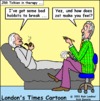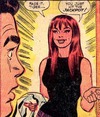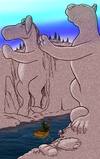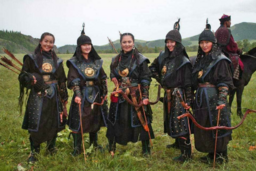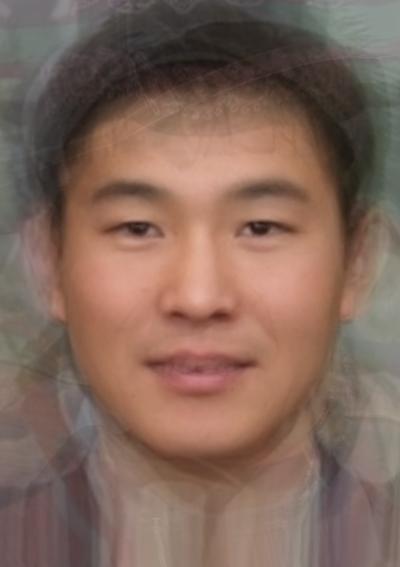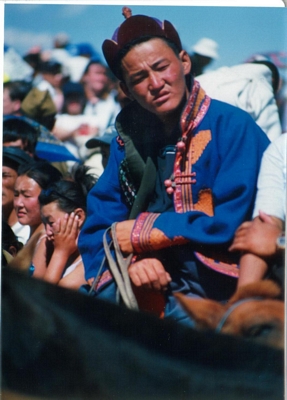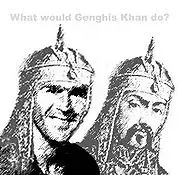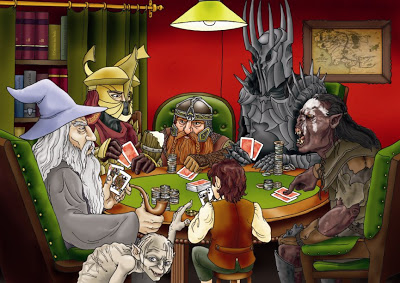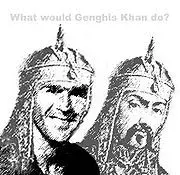“Monsterized Saracens,” Tolkien’s Haradrim, and
Other Medieval “Fantasy Products”
MARGARET SINEX
In 1995, Virginia Luling suggested that Sauron’s Easterlings and Southrons
“draw on inherited images of ‘paynims’ and other enemies” (56-
7). Others, such as
Patrick Curry, have noted the geographical parallel
between the Haradrim living to Gondor’s south in the “Sunlands” and
medieval Christendom’s perceived enemies to the south and east. Curry
writes: “Tolkien’s evil creatures are frequently ‘swart, slant-eyed’ and tend
to come from the south (‘the cruel Haradrim’) and east (‘the wild Easterlings’)
both threatening directions in [his] ‘moral cartography’” (30-31).1
Most recently, Dimitri Fimi contextualizes Tolkien’s notions about race
by examining theories advanced in the late Victorian period and early
twentieth century in several fields (physical anthropology and philology
among them) as well as the influences of Social Darwinism and the Eugenics
movement.2
Writing from a multi-cultural perspective, Brian McFadden and Jane
Chance have examined relations among the Races of Middle-earth and
have illuminated the Haradrim’s indebtedness to the sigelwara or Ethiopians
of Old English and Anglo-Latin literature. In this essay, I wish to
explore the contributions of later English texts, Middle English romances
in particular. Tolkien did not simply select traits from the “monsterized
Saracens” (Cohen Giants 78) of English romance and the French epics
and bestow them unaltered on his Men of Harad. Within the terms of
his fiction, Tolkien mirrors the Western Europeans’ methods of constructing
their imaginary Saracen.3
I say “imaginary” because, as many have noted, in Jeffrey Jerome
Cohen’s words: “‘Saracens’ are fantasy products of the Christian imaginary,
that, like all monsters, could take on an uncanny life of their own”
(Cohen “Hybrids” 88). He makes this remark in the context of analyzing
the process of “othering” in the letters of John of Salisbury (1115-1180).
In these letters, John represents the Welsh people in ways that Cohen
demonstrates: “are manifestations of an othering impulse also visible behind
the racialized representations of Islam disseminated throughout the
Latin West” (88). “Impulse” conveys an urgency, a drive perhaps, to demarcate
“the Welsh” or “Muslims” as the Other distinct from European
Christians.
When pondering this othering impulse, Paul Freedman cautions that
the viewpoint of the European Christian elite was neither perfectly unified
nor unchanging over the centuries. Such a claim oversimplifies the
176
Margaret Sinex
matter as “cracks” in this viewpoint are readily apparent (11). Freedman
offers the further caveat that the term “Other” itself is not perfectly
stable:
A second problem is the tendency to treat alien or Other as
if they were stable terms denoting complete and consistent
rejection when in fact there were degrees of marginality, so
much so, that seemingly contradictory positions could be
held simultaneously. (10)
We should, he warns, remain conscious of the range of types and gradations
of marginality (11). One such degree or gradation might rest on
the geographical distance between the targeted group and the European
intellectual. There was a distinction to be made, the learned believed,
between lepers who lived in Christian Europe (and yet were set apart)
and pagan Saracens who lived outside of Europe in remote, ill-defined
lands to the east.
Keeping Freedman’s cautions in mind, when I assert that Tolkien
mirrors the Western Europeans’ methods of constructing their imaginary
Saracen I am suggesting that he is necessarily mirroring the othering
process of the Christian West. Three characteristics of the othering
processes of medieval Europe are especially relevant to the Haradrim it
seems to me. The first is the reliance on binaries (inner/outer, light/dark,
Scythian/Ethiopian, saved/damned). Both medieval Church authorities
and ethnologists reconceptualized pairs of opposed elements that they
had inherited from the classical period. The second feature is the determining
power of climate on various races and thus the crucial significance
of geography in racial theorizing. And the third is the use of color
as a tool with which to guide audience response to characters in literature
and the visual arts of the late Middle Ages.
The issue of gradations of marginality has a bearing on the Haradrim
as well. They appear as one term or component of a number
of binaries (Men of the North/ Men of the South, light skinned/ dark
skinned) but only, I will argue, up to a point. I will show that they inhabit
an intermediate space, a space between the Men of Gondor and their
human allies on the one hand, and the “troll-men” of Far Harad on
the other (RK, V, vi, 123). The Men of Harad do not possess the “same
degree of Otherness” (Freedman 11) as do these hybrids, the troll-men.
Like the “monsterized Saracens,” they never lose their humanity; as
Cohn observes: “for all their [the Saracens’] disturbing distortions [they]
were recognized as essentially human” (“Hybrids” 78). Indeed, the Southrons’
preferences, such as their choice of weaponry and their love of
personal ornamentation, are akin to those of the Men of Gondor and
Rohan.Tolkien’s decision to parallel or mirror these aspects of medieval
177
“Monsterized Saracens”
othering processes has exposed him to the charge of being personally
racist, an accusation to which I will return at the conclusion.
As a race, the Men of Harad have three identifying characteristics:
particular physical features, specific moral failings and a blazing hot
homeland. The following is a representative description:
‘Dark faces. . . . They are fierce. They have black eyes, and
long black hair, and gold rings in their ears; yes, lots of beautiful
gold. And some have red paint on their cheeks, and red
cloaks; and their flags are red, and the tips of their spears;
and they have round shields, yellow and black with big
spikes. Not nice; very cruel wicked Men they look. Almost
as bad as Orcs, and much bigger. Sméagol thinks they have
come out of the South beyond the Great River’s end.’ (TT,
IV, iii, 254)
Gollum’s observations and speculations about the Haradrim summarize
the defining traits that The Silmarillion and The Lord of the Rings repeatedly
confirm. The Haradrim are Sauron’s obedient allies; their complexions
(eyes, hair and skin) are consistently dark and their chosen colors are red,
yellow and black. They are malevolent (“very cruel wicked”). They dwell
in the far South.
Let us first recall what the Silmarillion tells us about the particularly
long-lived nature of the Haradrim’s inner weaknesses. Their vulnerability
to Sauron’s call stretches back centuries into the Second Age well
before his defeat in the year 3262 when he is returned to Nûmenor as a
war prisoner. Not only does he compel their political obedience but he
also elicits religious veneration:
In the east and south well nigh all Men were under his dominion,
and they grew strong in those days and built many
towns and walls of stone, and they were numerous and fierce
in war and armed with iron. To them Sauron was both king
and god; and they feared him exceedingly, for he surrounded
his abode with fire. (S 289-290)
Further, the Haradrim welcome and embrace two of the many Nûmenoreans
whom Sauron corrupts during his captivity between 3262
and 3310:
Therefore many of those who sailed east in that time and
made fortresses and dwellings upon the coasts were already
bent to his will, and they served him gladly in Middle-earth.
But because of the power of Gil-galad these renegades, lords
both mighty and evil, for the most part took up their abodes
178
Margaret Sinex
in the southlands far away; yet two there were, Herumor and
Fuinur, who rose to power among the Haradrim, a great and
cruel people that dwelt in the wide lands south of Mordor
beyond the mouths of Anduin. (S 293)
Subsequently over the course of the Third Age, the Kings and Stewards
of Gondor fight numerous wars with the Haradrim. And centuries of
history justify the words of Faramir’s men to Frodo and Sam: “‘Now of
late we have learned that the Enemy has been among them, and they are
gone over to Him—or back to Him—they were ever ready to His will
—as have so many also in the East’” (TT, IV, iv, 267-268).
The above passage from The Silmarillion explicitly highlights their cruelty
for special attention, and hundreds of years later while watching the
Haradrim march to the Black Gate, Gollum again confirms it: “‘very
cruel wicked Men they look’” (TT, IV, iii, 254). Boromir too speaks of
“‘the Easterlings and the cruel Haradrim’” at Elrond’s Council (FR, II, ii,
258). Later his brother echoes his language—literally—when explaining
to Frodo and Sam Gondor’s affinity with northern peoples who are “‘unlike
the wild Easterlings or the cruel Haradrim’” (TT, IV, v, 286).
As the verbal repetition underscores, the Haradrim’s failings have
remained consistent for centuries. Equally consistent and long-lived were
the moral failings imputed to the medieval Saracen; European Christians
charged him with idolatry, devil worship and polygamy.4 And medieval
ethnological theory drew a crucial correspondence between a race’s inner
spiritual state and its outer appearance. Bodily features deviating
from the aesthetic canons of the western European analyst—such as a
very dark complexion—were often held to be deformities signaling serious,
hidden, spiritual defects.
Medieval ethnologists’ speculations about blackness of skin and
its significance were rooted in Greco-Roman theorizing. The ancient
Greeks established opposing categories of “Greek” and “non-Greek”
as they accounted for variations in physical appearance and unfamiliar
cultural practices among the peoples they encountered (Snowden 169).
The Romans perpetuated this binary opposition—there were Greeks
and Romans on the one hand and “barbarians” on the other (171). Early
Christian authorities adopted the term and altered its meaning “to refer
to all non-believers” (171).
As they pursued their ethnological and geographical enquiries, the
ancient Greeks established what would become a long-lived and influential
binary—a radical polarity between Scythians and Ethiopians—a
polarity so entrenched that it became a topos. These terms often denoted
peoples living in quite large geographical areas—the far north and the
far south respectively—when used by authorities such as Ephorus (4th c.
BC) and Strabo (64 BC–ca. 24 AD) (Snowden173). Greek writers used
179
“Monsterized Saracens”
the Scythian/Ethiopian antithesis to illustrate the effects of environment
and climate on humanity and the adaptations people make to those conditions.
Aristotle (383–322 BC) teaches that the extremes of northern
and southern climates can explain characteristic physical features: “a fluid,
moist atmosphere” produces the Scythians’ “straight hair”; the “dry”
climate of the extreme south produces the Ethiopians’ “woolly hair”
(173). Similarly Pliny the Elder (23/4–79 AD) writes: “Ethiopians are
. . . burnt by the heat of the sun near them and are born with scorched
complexions and frizzly hair, whereas the races in the opposite regions of
the world have straight, yellow hair and white, frosty skins” (174).
Ptolemy of Alexandria (ca. 100–170 AD) adds a further, crucial dimension,
one that exerted an enduring influence. He demonstrates that
climate also shapes the characteristic behavior of races: “the Ethiopians
are for the most part savage because their homes are oppressed by the
heat and the Scythians are savage because their dwellings are continually
cold” (175). Another binary describing opposing temperaments is added
by Bartholomaeus Anglicus (fl. 1230–1250): “The visible signs of cowardice
and boldness are dark skin and white skin, for the heat of the sun
makes men “blacke of face,” while coldness is the “modir of whitness”
(Akbari 24).
Referring to Pliny’s account of Ethiopians in his Natural History and
to what he calls the “moral overtones” in Ptolemy’s discussion in his Tetrabiblos,
John Block Friedman observes: “it was but a short step from the
quasi-science of such portraits of the Ethiopian to treatments in which
he is morally inferior to Western man” (55). Citing medieval characterizations
of Ethiopians and Saracens, Friedman continues: “color polarities
were easily exchanged with moral polarities, and the blackness of
immorality contrasted with the whiteness of salvation” (64-65). Blackness
of skin became a spiritual sign for early writers of homilies such as
Paulinus of Nola (354–431AD) who taught: “they were burned black not
by the sun but by vices and sin” (65).5
We can see then that medieval Europeans came by their use of binaries
(Scythian/Ethiopian, white/black, saved/damned) to analyze racial
differences honestly, which is to say, they inherited them from Antiquity.
Unfamiliar physical traits such as black skin (unfamiliar, that is, to the
European ethnologist) signaled grave spiritual flaws—“vices and sins.”
We can also see the great power classical and Church authorities ascribed
to climate as a crucial force that determined distinctive racial temperaments
and behaviors.6 With these aspects of medieval thought in mind,
we can appreciate how particularly apposite is Patrick Curry’s phrase
“Tolkien’s moral cartography” when applied to The Lord of the Rings. John
F. G. Magoun also notes the “complex interaction of place, direction and
meaning” in the novel:
180
Margaret Sinex
The North is no longer the location of any evil power, but
is the story’s geographic and moral home . . . The story expands
to the South, with a gentler climate and a long history
of conflict. That is where Gondor . . . wars with Mordor and
its allies to the east and south.
Beyond Gondor, on the edge of the map and the story, are
the little-known nations of The Harad from Sindarin (south).
These are hot lands whose fierce dark-skinned peoples, the
Haradrim or “Southrons” . . . . (622)
I would now like to consider the etymology of another name for this
“fierce dark-skinned” Race from the South—the Swertings.
The root of Swertings derives from OE sweart an adjective meaning
“swart, swarthy, black, dark” (Bosworth and Toller). In a figurative
sense sweart could also suggest the “absence of good, black (crime)” (Bosworth
and Toller). In the first of his two articles on “Sigelwara Land”,
Tolkien notes the reference to “black color” (sweartes hiwes) in the Old
English Wonders of the East in the Beowulf manuscript: “Ðær moncy is
<seondon> sweartes hiwes on onsyne, þa mon hateð sigelwara” (189);
“There is another race of people there of black color to look at, who
are called Ethiopians (sigelwara).”7 Tolkien adds a further example of the
element sweart meaning “black” in the Old English glosses on Aldhelm’s
De Laudibus Virginitatis —“ethiopica nigredine, sylhearwenre sweartnyse” (189).
Here, the noun sweartness, means “blackness” corresponding to the Latin
nigredo (Bosworth and Toller). Further Tolkien explains that for the authors
of these texts, Ethiopians were a black-skinned race, a color that
also had moral implications for later medieval Christian writers. Of the
compound Sigelhearwan Tolkien concludes:
As it has come down to us the word is used in translations
(the accuracy of which cannot be determined) of Ethiopia,
as a vaguely conceived geographical term, or else in passages
descriptive of devils, the details of which may owe something
to vulgar tradition, but are not necessarily in any case
old. They are of a medieval kind, and paralleled elsewhere
. . . . Ethiopia was hot and its people black. That Hell was
similar in both respects would occur to many. (192)
Let us consider the perceived similarities between the inhabitants of
Ethiopia and of Hell. In his second article, he notes that Anglo-Saxon
homiletic literature depicts the Sigelhearwan “as devils” (108) and that they
have all the requisite body parts except horns: “tusks, claws, beards to
their toes, wings like besoms and dreadful nebs” (109). Homiletic texts
also added other “fantastic” elements to the conflation of the Ethiopian
and the devil: “The fantastic notions associated with Sigelhearwan in homi181
“Monsterized Saracens”
letic literature may be wholly foreign and relatively late; for the learned
placed dragons and marvellous gems in Ethiopia, and credited the people
with strange habits, and strange foods, not to mention contiguity with
the Anthropophagi” (192).
Further, Tolkien also suggests that the Sigelhearwan are related to the
followers of the Old Norse fire giant Surtr as Tom Shippey and Brian
McFadden both note. Tolkien favors this identification writing: “If this
guess is worth considering” the ancestors of the Silhearwan are “the sons
of Múspell” . . . with red-hot eyes that emitted sparks, with faces black as
soot. In any event, Tolkien concludes that the origins and development
of the element heawra are lost to us: “heawra [belongs to] that large part
of ancient English language and lore which has now vanished beyond
recall, swa hit no wære.” 8
The notion that the black skin assigned by Anglo-Saxon homilists
to this Ethiopian/devil figure signaled grave moral defects persisted for
many centuries. Following the Anglo-Saxon period, later English authors
habitually conflated the figure of the Ethiopian and that of the Saracen.
French writers often fuse the two in crusader chronicles, epics and chansons
de geste. The Middle English romances frequently present the Saracen
too as a black man (Friedman 226 n 14) and Tolkien certainly was
familiar with him.
Before looking at some of these black-skinned Saracens, I think it
is worth quoting in full Geraldine Heng’s discussion of blackness as an
important prompt for the audiences of these romances in her essay “The
Romance of England”:
the late medieval European discourse on color is, of course,
unstable and riven with contradictions; however, the point
to be made is that blackness is not neutral, but negatively valenced,
in the epistemic formation I describe. That a racializing
discourse exists in which color is positioned instrumentally,
from the thirteenth century onward, is inescapable: The
attention to blackness and variations on blackness, in cultural
texts ranging from romances like the King of Tars, Moriaen,
and Parzival, to the statuary of St. Maurice, and the visual
representations of Lady Fortune . . . suggests a discursive
system in place to guide responses to characters and fictions
from cues supplied by color.” (163 n. 7)
Heng identifies blackness as one tool in a pervasive discursive system
and one with a pejorative charge. Her suggestion that this system
could apply to visual depictions finds support from art historian Debra
Higgs Strickland. Commenting on the symbolism of a dusky complexion
in the visual arts of the High Middle Ages, she writes: “dark skin was
182
Margaret Sinex
attributable to the effects of the sun, but . . . it carries primarily negative
symbolic value in images of virtually all of the Church’s enemies, from
Ethiopians to Jews to Muslims”(179). Strickland also cautions: “no color
may be said to carry absolute meaning during the Middle Ages, but the
weight of contemporary literary evidence suggests that black was interpreted
negatively in numerous contexts, especially Christian ones” (84).
The Saracen figure who emerges from the following English romances
has inky black skin and gigantic proportions. (These texts hardly
constitute an exhaustive list.) These physical features identify him as the
offspring of the devil and also ascribe to him the sin of idolatry. In Sir
Ferumbras Roland calls all his Islamic enemies “þe Sarsynȝ blake” (line
2785). And the romance again specifies the coal black skin of their gigantic
Saracen guardian Agolafre: it is “as blak so pych” (4329). Likewise
the Saracen champion Vernagu of Rouland and Vernagu is also “swart as
piche” (line 483).9 Viewed through Christian eyes, as the French peer
Richard asserts, the black giant Agolafre is seen to be the devil’s spawn:
“Ne saw y neuere non hym lyke, He semeþ ful wel þe deuels chyke, ysprong
of þe pyt of helle” (Sir Ferumbras 4332). In the romances, bodily
disfigurement signifies inner depravity, and in this text, the sins of idolatry
and devil worship. Sir Ferumbras offers us a particularly literal dramatization
of the Saracens’ devil worship. Here, the devil appears to speak
to the Emir Balan using the Emir’s idol of “Mahoun” as a mouthpiece
(5140–5144).10
The Middle English romances bequeathed both to us and to Tolkien
many other demonic “monsterized Saracens” as did the French tradition.
And indeed in 1967, Matthew Hodgart pointed out the French contribution.
He remarks upon the battle between “God and the Devil” he
perceives in Tolkien’s novel and draws a parallel between opposing forces
in The Lord of the Rings and those in The Song of Roland: “for a parallel in
medieval literature we must look to works written under the inspiration
of Christian doctrine: to the Chanson de Roland, with its straight conflict
between good Christians and bad Saracens” (11).11 Here, Hodgart makes
explicit the way in which The Lord of the Rings mirrors the use of binaries
we have traced in Western European racial theorizing—Christian/Saracen,
good/bad. And both the “color polarities” and the “moral polarities”
(Friedman 64–65) as they are reflected in Tolkien’s novel have provoked
criticism over decades. In his essay on the Haradrim, Brian McFadden
lists a number of opposed pairs: “light/dark, good/evil, beauty/ugliness,
[and] Elf/human” (211).
Tolkien’s use of binaries and the white/black opposition (long burdened
with its spiritual meanings) in particular has drawn comment from
many. In his 1956 review, Anthony Bailey critiques Tolkien’s use of “simple
morals” asserting:
183
“Monsterized Saracens”
First of all, the whole treatment is black and white: my chief
complaint is that there is no grey in it. This is one reason why
The Lord of the Rings never approaches Alice in Wonderland or
Malory; after a while one longs for a relationship with some
complexity, but there are here no Lancelots nor Guineveres.
(154)
In the same year, Edmund Wilson “set the gold standard” for faulting
Tolkien’s use of moral absolutes: “What we get is a simple confrontation—
more or less the traditional terms of British melodrama—of the
Forces of Evil with the Forces of Good, the remote and alien villain with
the plucky little home-grown hero” (313). A decade later, Matthew Hodgart
asks: “but isn’t [The Lord of the Rings] really a parable, consciously
aimed at putting across the general Christian view that the universe is a
battlefield between the forces of good and evil” (11)?12
Throughout subsequent decades, discussion of this binary (so disturbing
to many readers) has continued. In his 1977 essay “Color Symbolism
in The Lord of the Rings”, Robert A. Bunda finds black equated with
“pure evil” and white [with] “pure good” (14). Likewise Walter Scheps
remarks: “if evil is associated with blackness, we would expect good to be
described in terms of whiteness; and so it is” (43). So too Patrick Curry
in Defending Middle-earth: “it is also true that black—as in Breath, Riders,
Hand, Years, Land, Speech—is often a terrible colour, especially when
contrasted with Gandalf the White, the White Rider, and so on” (31).
Curry, however, believes “the primary association of black here is with
night and darkness, not race” (31).13
I would like now to turn to the two other colors consistently associated
with the men of Harad—red and yellow—those chosen for their
personal adornment. Bunda has noted that these three colors mark the
Southrons as Sauron’s servants. Indeed, they are his colors. In support he
recalls the Eye as revealed in Galadriel’s Mirror: “‘the Eye was rimmed
with fire, but was itself glazed, yellow as a cat’s, watchful and intent,
and the black slit of its pupil opened on a pit, a window into nothingness’”
(Bunda 15, Tolkien FR, II, vii, 379). A description of another of
his servants, the Orcs, explicitly adds red: “‘[they] are filthy black creatures,
possessing red eyes and tongues, and yellow fangs’” (14). I do not
find compelling Bunda’s assertion that the red and yellow necessarily
“heighten the hideousness of their form” (14). But these three colors,
when found together, did serve to demarcate the moral landscape in the
visual arts of the Middle Ages.
In her impressive study Saracens, Demons, and Jews: Making Monsters in
Medieval Art, Strickland convincingly demonstrates what she calls a “common
pejorative visual vocabulary” across a range of art forms and media
184
Margaret Sinex
that helped European viewers recognize their perceived foes, its target
races (Saracens, Jews, Tartars and others.) This vocabulary included conventional
markers such as particular clothing items (Saracens have turbans)
and exaggerated physical features (prominent thick lips, and large,
often bulbous noses) (173). It also included color-coding:
Both yellow and red are colors that feature consistently in
pejorative images of Jews, and both colors had contemporary
associations with criminals and other social undesirables
including Jews themselves once they were forced to wear the
yellow badge of infamy in certain regions. (110)
I have selected three of her many examples to illustrate this particular
use of color in two media, stained glass and manuscript illustrations.
The first depicts Jews, the second Saracens and the third both groups
together. The first example is a series of stained glass windows (c. 1479)
from the St. Lawrence Church in Nuremberg that depict Jews worshipping
the Golden Calf, an incident recounted in Exodus 32: 1-6 and Kings
3: 28-30. Yellow predominates in these panels. Not only is the Calf yellow
but the fashionable fifteenth-century attire of most of the dancing
Old Testament Jews is yellow as well. And so are their identifying “funnel
caps” topped with knobs (110).14 Here, the artist’s choice of visual clues,
including color and contemporary clothing, encouraged the Christian
faithful inside the St. Lawrence Church to merge the Old Testament Jews
of long ago with contemporary Jews in their imaginations, and further,
to suggest a historical continuity in their practice of idolatry. Strickland
reminds us that the mendicant orders of the thirteenth century in particular
accused the Jewish people of idolatry (108). Artwork in various
media promoted the belief that medieval Jews were “the inheritors of the
demonic depravity of their forebears”(109).15
In my second example, the illuminator of a series of thirteenth-century
illustrations from the Vienna Bible employs the same colors to identify
the church’s foes. Yet here, her adversaries are Saracens as the accompanying
moralizations make explicit. These images illustrate events
in Kings 1: 4-5 in which the Philistines seize the Ark of the Covenant
from the Jews. In a curious but potent anachronism, the texts substitutes
Saracens for Philistines who “take the ark that they had conquered and
put it in their mosque (mahommeri) beside one of their gods Dagon” (quoted
in Strickland 171). The moralizing text instructs the reader to equate
these Saracens with devils and the ark with the church: “that the Saracens
placed the holy ark beside one of their idols named Dagon signifies
the devils who put the Holy Church, which they have stolen, beside one
of their masters named Beelzebub” (quoted in Strickland 171). Drawing
attention to the Saracens’ skin color, Strickland observes: “the Saracen185
“Monsterized Saracens”
devils bear the skin colors of infamy: red, yellow and black” (172). They
are Saracen-devils indeed because while still clothed in their robes, they
possess some body parts of wild animals: long pointed ears, legs ending
in three-toed paws, toothy grins and protruding noses. With tremendous
economy, both text and image conflate the Saracen with the monster and
accuse him of idolatry and of devil-worship. I will return to the use of
animal body parts presently in regard to the “monsterized Saracen” and
Tolkien’s Men of Harad.16
In my last example, Jews and Saracens figure together as Christ’s
committed foes in an illustration from the Wellcome Apocalypse, one of
a body of Apocalypse manuscripts. Strickland considers this German
work (c. 1420) an especially literal depiction of the Jewish race imagined
as Christ’s enemy despite the expectation of their conversion to Christianity
at the dawn of the Second Coming. A number of pejorative visual
signs (including color) mark both Jews and Saracens as they stand in line
waiting to receive the Mark of the Beast. The three Jewish figures begin
the line-up directly in front of the Beast, their position perhaps suggesting
their zeal to serve Antichrist (214). All three have very full beards and
wear the stylized Jewish hat. One carries his moneybag, which is yellow;
on his breast he wears the yellow “badge of infamy” (215).17 A bit farther
back in the line waits the Saracen who wears his identifying turban and
stands next to a dog.
Tolkien’s own choices demonstrate that he was well aware of this
color-coding as part of the negative visual vocabulary used for the target
races in the medieval period. He is no less consistent in the colors he gives
his Southrons than were the artists whose work Strickland examines. He
employs the colors of infamy in every description of the Haradrim found
in The Lord of the Rings. Consider the description with which we began:
‘Dark faces. . . . They are fierce. They have black eyes, and
long black hair, and gold rings in their ears; yes, lots of beautiful
gold. And some have red paint on their cheeks, and red
cloaks; and their flags are red, and the tips of their spears;
and they have round shields, yellow and black with big spikes.
Not nice; very cruel wicked Men they look. Almost as bad as
Orcs, and much bigger. Sméagol thinks they have come out
of the South beyond the Great River’s end.’ (TT, IV, iii, 254;
my emphasis)
In his reading of this passage, Bunda assigns specific moral values
to the colors of infamy: “the dark eyes, hair, and skin of these men are
symbolic of the evil they serve. The red of their cheeks, cloaks, flags, and
spears represents the fire and blood which follows [sic] in the wake of
evil. Finally, these men wear their gold booty, whereas the men of virtue
186
Margaret Sinex
have gold inherent in their very being through their hair, implying that
inside, their hearts are also of gold” (15).
We find the same colors in the passage describing a fallen Southron
warrior at close range:
He came to rest in the fern a few feet away, face downward,
green arrow feathers sticking from his neck below a golden
collar. His scarlet robes were tattered, his corslet of overlapping
brazen plates was rent and hewn, his black plaits of hair
braided with gold were drenched with blood. His brown hand
still clutched the hilt of a broken sword. (TT, IV, iv, 269; my
emphasis)18
Even their great beast of war—the Mûmak—wears their identifying colors:
“his upturned hornlike tusks were bound with bands of gold and
dripped with blood. His trappings of scarlet and gold flapped about him in
wild tatters” (TT, IV, v, 270; my emphasis).19
By choosing these colors for these servants of the Dark Lord, Tolkien
adopts the color-coding employed by visual artists to designate the enemies
of medieval western Christianity. And yet, he does not use the full
range of the “common pejorative visual vocabulary” Strickland documents
so thoroughly. The faces of his Haradrim do not reveal the exaggerated
features often found in those of Jews and Saracens depicted
in medieval artwork. Rather, with their gorgeous saturated colors they
are a handsome people whose demeanor is marred only by their evident
cruelty and pride. And significantly, they share with the men of Gondor
and Rohan a taste for the decorative arts and similar weaponry, crucial
elements I will address presently.
In England, the romances marked the Saracen enemy (especially
their army’s champion) by giving him not only black skin, but also giant
proportions, and a body composed of human and bestial elements, a
monstrous hybrid. These physically scrambled creatures recall the Saracens
of the Vienna Bible with their sharp, fox-like ears and three toed
paws. Like so many of his ilk, Alagolofur of The Sowdone of Babylone has
skin “so blake and harde” (l. 2193). He has a head of a leopard (l. 2193,
2198) and also sports “tuskes, like a bore” (2197). Their protective skin
is often that of a beast. In Sir Ferumbras, snakeskin covers the head and
body of Agolafre: “For he was þanne to-be-toȝ/ body & heued y-same/
With an hard crested serpentis fel” (l. 4540–41). The champion Vernagu
has sharp bristles on his brow: “his browe as brestles wore” (Rouland and
Vernagu l. 479). The English romances often offer audiences some very
precise measurements of both specific body parts and general stature.
Vernagu’s relevant stats include a face four feet wide, a nose one foot
across, a shoulder span of fifteen feet and an overall height of forty feet
187
“Monsterized Saracens”
(l. 473-478). Agolafre stands fifteen feet high (Sir Ferumbras 4329). And
fully armed, Octavian’s Aregeous towers over his foes at twenty feet (l.
836–38).
The demonic spiritual darkness of the Saracen conjured by these
English romances is marked in his flesh by bestial appendages, supernatural
dimensions and other grotesque distortions. While well aware of
these conventions, Tolkien chose not to inflate particular body parts of
his Haradrim. No man of Harad has a nose one foot wide, nor shoulders
fifteen feet across. None can rival Aregeous standing at twenty feet.
Instead, the text emphasizes their affinities with the other races of Men.
They hold some aesthetic values in common with their foes such as their
love of decoration. The Southrons’ long, black hair is orderly and they
have “braided it with gold” (TT, IV, iii, 254) unlike the “brestles” of
Vernagu, the Saracen champion. They have also painted their cheeks
red. And they share with the Men of the West a love of ornamentation,
wearing “‘gold rings in their ears’”(TT, IV, iii, 254). The fallen warrior
Sam contemplates wears a gold torque.
Their weaponry also decisively marks them as Men as opposed to giants
when considered within the conventions Middle English romances.
Like the Men of Gondor and their allies, some Haradrim wear corslets;
they fight with swords, spears and shields and carry flags and banners
into battle. The audience of the medieval romance recognized these armaments
as part of the world of western European chivalry. Giants did
not carry them. The giant champion Enfachoun of Sir Ferumbras wields
an iron maul (4653). Agolfre, the bridge guardian, bears a massive axe
measuring three feet across and made of tempered steel (4432-4433).
And, while Alagolofur of The Sowdone also brandishes an axe (2176) Arageous
menaces his opponents with a steel club in Octavian (996-7). Their
choice of weapons was thought to belie their ignorance chivalric conventions.
20 Mauls, axes and clubs conveyed the Saracens’ status as exiles
from the civilized center of the Latin West, certainly from the European
ethnologist’s point of view.21
These cultural affinities the Haradrim share with the Men of the
West, however, do not extend to those who dwell in Far Harad. They are
not purely or cleanly men. The text compares them to hybrids, in this
case, a mix of trolls and men. As a second wave of enemies floods the
Pelennor Fields, the defenders of the city see: “Easterlings with axes, and
Variags of Khand, Southrons in scarlet, and out of Far Harad black men
like half-trolls with white eyes and red tongues” (RK, V, vi, 121; my emphasis).
Subsequently, the text drops this simile and they become “troll-men”
in the following passage: “[the forces] of Dol Amroth driv[e] the enemy
before them: troll-men and Variags and orcs that hated the sunlight” (RK,
V, vi, 123; my emphasis).
188
Margaret Sinex
Here are the intense contrasting colors—black, white and red—commonly
found in the chansons de geste, crusader chronicles and later romances,
whose narrative gaze looks at the face. To take but one example
from The Song of Roland, the hero’s “accursed” enemies are described as:
“blacker than ink/ And have nothing white save their teeth” (Burgess
1932–33). In his seminal article on the Saracen figure, William Wistar
Comfort offers this description from Les Narbonnais: “their bodies are
huge and black as ink, long behind and short in front. Their eyes were
as red as burning coals” (650–51). Geraldine Heng, in her study of the
Middle English Richard Coer De Lyon offers the following description of a
Saracen’s head on a plate: “narrative attention zeroes in on the black face
and black beard of the detached head, set off against white teeth that are
bared by widely grinning lips” (136).22
Servants of Sauron though they may be, the Southrons are not hybrids.
As I stated in my introduction, they do not possess the same degree
of Otherness as do the troll-men. From the perspective of those in Minas
Tirith, the Haradrim inhabit a space between the Men of Gondor and
the hybrids of Far Harad in terms of both race and geography. The
geographical placement of these “troll-men” far away, farther away than
even the Swertings parallels the Christian West’s imagining of their “fantasy
products” in lands remote from Western Europe; “extreme people
will be found in extreme places” (Friedman 43). In his essay Brian Mc-
Fadden explores in some detail the way in which geography can be used
as a distancing technique and considers language as another.23
It is significant, I think, that The Lord of the Rings offers us only an impression
of the sound of the Haradrim’s speech, never a specimen of the
language itself. It sounds “harsh” and “hoarse” and feels both discordant
and disagreeable to their foes. As the Haradrim march to the Black Gate,
Frodo, Sam and Gollum hear their “hoarse shouting” (TT, IV, iii, 253).
And again, at the retreat from Osgiliath: “wild Southron men with red
banners, shout[ed] with harsh tongues, surging up, overtaking the retreat”
(RK, V, iv, 93; my emphasis). Evoking the (unpleasant) aural experience in
this way is another means by which the text “others” the Haradrim.
In contrast, Frodo and Sam can understand the speech of Faramir’s
men as they converse: “in soft voices, at first using the Common Speech,
but after the manner of older days, and then changing to another language
of their own” (TT, IV, iv, 267; my emphasis). And significantly,
when Frodo recognizes this other language as the Elven-tongue or a
dialect of it, he can then integrate the speakers—Mablung and Damrod—
into his own worldview, gaining a sense of connection. He realizes
that they are “of the line of the lords of Westernesse.” As in their speech,
the contrast between their physical appearance and that of the Swertings
is marked; “they were goodly men, pale-skinned, dark of hair, with grey
eyes and faces sad and proud” (TT, IV, iv, 267). Here we see both physi189
“Monsterized Saracens”
cal traits and language demarcating these two races of Men: the “‘High,
or Men of the West’ as opposed to ‘the Wild, the Men of Darkness’” as
Faramir classifies the Men of Middle-earth (TT, IV, v, 287).24
Tolkien’s attentiveness to the aural impression of speech heard but
not understood evokes something analogous to the ancient Greeks’ experience
of encountering the Other. The Greeks considered language a key
means of distinguishing between men and beasts, and between Greek
and non-Greek. Friedman reminds us: “the use of articulate speech distinguishing
men from animals and non-men, was not enough to confer
full humanity. The speech had to be Greek, for the sounds of the non-
Greek speaking “other” were not the true communications of rational
men” (29).
And yet, as many have noted, this unpleasant cacophony is not the
sole impression of the Haradrim Sam (at least) receives.25 His crucial
ability to imagine the world from the perspective of another triumphs as
he meditates on the fallen Swerting warrior:
It was Sam’s first view of a battle of Men against Men, and
he did not like it much. He was glad that he could not see
the dead face. He wondered what the man’s name was and
where he came from; and if he was really evil of heart, or
what lies or threats had led him on the long march from
home; and if he would not really rather have stayed there in
peace. (TT, IV, iv, 269)
Sam’s curiosity is neither cold nor morbid but appealing in its sympathy.
He imagines what he shares with his enemy, not what divides them.
In speculating about his foe’s proper name, he makes him an individual.
And most impressively, he wonders whether the dead man was torn inwardly
by conflicting motivations as he himself is at times. After taking his
“peep” in Galadriel’s Mirror, his duty to his master wars with his longing
to be home again in the Shire. Sam chooses “to go home by the long road
with Mr. Frodo” (FR, II, vii, 378) but here in distant Ithilien, he has the
imaginative reach to ask what induced this man to begin his own “long
march from home.” Sam can conceive of more than one possibility—his
enemy is inherently evil, or, he is yet another victim of Sauron—coerced
by terror or manipulated by deceit. Perhaps terror overcame his own love
of home. It is an astonishing achievement of a human heart.26
As both Chance and McFadden have thoroughly demonstrated, the
judgments the newly crowned Aragorn delivers upon his defeated enemies
are equally impressive. Those Easterlings who surrender to him
are pardoned and made free. “The slaves of Mordor” are also freed and
given their own territory. Peace is made with the Men of Harad (RK, VI,
v, 247). These judgments are just and also express his forgiveness and
love, two qualities of crucial importance most especially when they are
felt for “those others who are different” as Chance writes (42).27 Only
through such spiritual victories can other races be embraced and integrated
and the lands truly healed.
In conclusion, I would like to return to the charge of personal racism
made against Tolkien in light of our exploration of those binaries
(Scythian/Ethiopian, white/black, saved/damned) so instrumental in
the Christian West’s racial theorizing in the medieval period. To some
readers of The Lord of the Rings, many conceptual binaries can appear
“suspiciously like racism” as McFadden notes (211). In our reading of
Tolkien, we cannot, of course, “see” without (in Fimi’s words) the lens of
our “modern perspectives on racism and racial discrimination” (158).28
It is equally true, however, that we may study medieval theorizing about
race dispassionately.
It is my hope that this essay may help suspicious and doubtful readers
recognize that the many pairs of polarizing binaries considered here
have ancient roots. As assimilated and adapted by the medieval church
they persisted, informing the theorizing of western European Christians
for centuries, not merely for a few decades. Indeed, it can be argued that
Tolkien’s choice to mirror the medieval ethnologist’s theorizing is perfectly
suited to his literary project especially if one believes (with Jared
Lobdell, for instance) that “the action of The Lord of the Rings indeed
mostly takes place in the north-west corner of Europe, and has a British
or English feel to it . . .” (87).29 His choice then would be intellectually
coherent rather than simply a kind of seasoning to infuse Middle-earth
with a “medieval” flavor.
That a literary work should mirror such conceptualizing is not a call
for readers to embrace it themselves. Nor, by the same token, does it offer
“proof ” of the author’s embrace of such conceptualizing. Understanding
should not, in my view, be confounded with advocacy.
Further, recent scholarship urges us not to equate the fictive mirroring
we have traced in the Secondary World of The Lord of the Rings with
the personal belief system of Tolkien the historical man. This is especially
true since we have clear extra-textual evidence (such as personal
letters, lectures and essays from the Primary World) expressing his views
about race and marginalization (as Chance in particular has demonstrated)
and about how the word “race” should be used and about whether
or not race has any link with language, culture and/or nation (as Fimi
has shown). The novel’s resolution celebrates the forgiveness and love
practiced by Aragorn in Gondor and Frodo in the Shire as well as the
empathetic imagination of Sam. These are the values that triumph, not
those implicit in Tolkien’s chosen methods of construction.
190
Margaret Sinex
NOTES
1 See also E. L. Epstein: “Tolkien’s Middle-earth . . . seems to be a picture
in little of medieval Christendom menaced by the southern and
eastern enemy, Sauron, who occupies the position of the Saracen
enemy of medieval Europe” (525).
2 Of particular interest to Fimi is the tendency of the anthropologists
and Social Darwinists to organize races into hierarchical schema, hierarchies
that are inherently judgmental, assigning greater value to
one race and a lesser value to another. This discussion informs her
study of hierarchical orderings of various anthropomorphic beings
found in The Lord of the Rings—distinct, tripartite classifications for
Elves, Men and Hobbits for example.
3 The term “Saracen” was used for the adherents of Islam in a broad
range of theological, legal and literary works (Strickland 165).
4 They also imputed idolatrous practices and devil-worship to the Jews
(Strickland 108–9) as well as ritual murder (104) and desecration of
the Host (116–17).
5 But see McFadden who writes: “the association of demons with Ethiopians
came when metaphoric discussions of color by Augustine and
Isidore were misunderstood and literally applied by later Christian
authors” (216). When the sigelwara, or Ethiopians appear in Anglo-
Latin and Old English literature, McFadden feels they are “vulnerable,
human and less fearsome with closer contact” (199).
6 See also Suzanne Conklin Akbari’s account of geography, climatic
determinism and race in “From Due East to True North: Orientalism
and Orientation” (24-29).
7 Orchard (202). See McFadden’s discussion of this and other Anglo-
Saxon references (202-203).
8 “Sigelwara Land II” (111).
9 Cited by Friedman (226 n 14).
10 The medieval Church claimed that other target races practiced
idolatry and devil-worship. As Strickland notes, this charge allowed
Christian Europeans to lump their enemies—Jews, Muslims and all
other non-Christians—together in the same category; she writes: “if
the object of worship was not the Christian God, it was by necessity
idolatrous”(168). The chansons de geste and crusader chronicles were
instrumental in constructing the figure of the idolatrous Muslim and
the romance genre in popularizing it (166).
191
“Monsterized Saracens”
11 Lobdell takes issue with his analysis (3).
12 See too Mark Robert’s 1956 review: “Nor are we troubled by one
of the drabbest aspects of real life, the way that people’s characters
are not simply black or white but various shades of grey: here the
good are very, very good and the bad are simply horrid” (455). This
is the kind of assessment C. S. Lewis sought to combat in his essay
“The Dethronement of Power” although it appeared a year earlier
(1955) in Time and Tide: “I think some readers, seeing (and disliking)
this rigid demarcation of black and white, imagine they have seen a
rigid demarcation between black and white people. Looking at the
squares, they assume (in defiance of the facts) that all the pieces must
be making bishops’ moves which confine them to one color” (12).
13 Curry also offers several “counter-examples” noting “Saruman’s sign
is a white hand . . .” (31).
14 Strickland draws our attention to one figure in the foreground of this
scene who embodies a number of these visual markers of the Jew:
“a long beard, a bright yellow funnel hat, bright red stockings, a face
turned in profile to highlight a stereotypically long Jewish nose, and a
somewhat stunted body in partial dorsal view” (110).
15 Strickland also cautions that not every medieval representation of
Jews was negative: “from the twelfth century onward in Northern
Europe, neutral, positive, and negative images were produced simultaneously,
albeit in varying proportions at different times and places”
(97).
16 See Salih’s discussion of hybridity as a persistent sign of paganism
and wrong belief (113).
17 See Strickland’s discussion of the range of associations the medieval
audience had with the Jew’s moneybag (140-41).
18 As Virginia Luling notes, this is the “one moment where one of them
becomes an individual” (56).
19 The description of the retreat from Osgiliath provides a further example:
“horsemen of the Enemy swept up. The lines of fire became
flowing torrents, file upon file of Orcs bearing flames, and wild Southron
men with red banners, shouting with harsh tongues, surging up,
overtaking the retreat” (RK, V, iv, 93; my emphasis).
20 See Friedman’s discussion of the significance of the club as a weapon
(32-33).
192
Margaret Sinex
21 See also Kline’s study of medieval cartography. She suggests that the
“wooden poles and mallets of varying shapes and sizes” bourn by
some of the Monstrous Races on the Hereford map carried the same
meaning for the medieval viewer (151).
22 Heng is using Karl Brunner’s edition of 1913.
23 See his reading of Genesis 11: 6-9 (201).
24 Cited by Fimi (148). Between the High and the Dark in this threetiered
hierarchy are “the Middle Peoples, Men of the Twilight.” See
her analysis of the classification of Men in the Third Age (148-149).
In his Secondary World Fimi notes that Tolkien links “the ‘racial’
characteristics of the Three houses of Men with their languages”
in the First Age, and this “despite Tolkien’s explicit statements
against the idea of a community of language and ‘race’ in English and
Welsh”[sic] (145).
25 Several critics have suggested that this scene was inspired by autobiographical
accounts of allied soldiers speculating about a fallen German
in the First World War; see Croft (48).
26 McFadden also discusses Sam’s efforts “to see the man’s humanity
and to imagine what he would be like if there had been no war”
(205). See his reading of the entire passage, pages 205-206.
27 See her discussion of their role in the reconciliation of the many different
races at the dawn of the Age of Men (42-43).
28 See her discussion “Tolkien and the charge of racism” (157–59).
29 Lobdell cites Tolkien’s 1967 letter to Charlotte and Dennis Plimmer:
“the action of the story takes place in the North-west of “Middleearth,”
equivalent in latitude to the coastlands of Europe and the
north shores of the Mediterranean …” (87).
WORKS CITED
Akbari, Suzanne Conklin. “From Due East to True North: Orientalism
and Orientation.” In The Postcolonial Middle Ages, ed. Jeffrey Jerome
Cohen. New York: Palgrave, 2000: 19-34.
Bailey, Anthony. “Power in the Third Age of Middle Earth.” Commonweal,
11 May 1956: 154.
Bosworth, Joseph T. and Northcote Toller, eds. An Anglo-Saxon Dictionary.
Oxford: Oxford University Press, 1898.
193
“Monsterized Saracens”
Bunda, Robert A. “Color Symbolism in The Lord of the Rings.” Orcrist 8
(1977): 14-16.
Chance, Jane. “Tolkien and the Other: Race and Gender in Middle
Earth.” In Tolkien’s Modern Middle Ages, ed. Jane Chance and Alfred
Siewers. New York: Palgrave Macmillan, 2005. 171–88.
Cohen, Jeffrey Jerome. “Hybrids, Monsters, Borderlands: The Bodies of
Gerald of Wales.” In The Postcolonial Middle Ages, ed. Jeffrey Jerome
Cohen. New York: Palgrave, 2000: 85–104.
——. Of Giants: Sex, Monsters, and the Middle Ages. Minneapolis: University
of Minnesota Press, 1999.
Comfort, William Wistar. “The Literary Role of the Saracens in the
French Epic.” Speculum 55:2 (1940): 628-59.
Croft, Janet Brennan. War and the Works of J.R.R. Tolkien. Westport, CT
and London: Praeger, 2004.
Curry, Patrick. Defending Middle-earth. Boston: Houghton Mifflin, 2004.
Epstein, E. L. “The Novels of J.R.R. Tolkien and the Ethnology of Medieval
Christendom.” Philological Quarterly 48:4 (1969): 517–25.
Fimi, Dimitra. Tolkien, Race and Cultural History: from Fairies to Hobbits. New
York and London: Palgrave MacMillan, 2009.
Freedman, Paul. “The Medieval Other: The Middle Ages as Other.” In
Marvels, Monsters, and Miracles: Studies in the Medieval and Early Modern
Imaginations, ed. Timothy S. Jones and David A. Sprunger.
Kalamazoo, MI: Western Illinois University, 2002: 1–24.
Friedman, John Block. Monstrous Races in Medieval Thought and Art. Cambridge:
Harvard University Press, 1981.
Hausknecht, Emil, ed. The Sowdone of Babylone and of Ferumbras his Sone who
conquered Rome. EETS: ES 38. rpt. London, 1969.
Heng, Geraldine. “The Romance of England: Richard Coer De Lyon, Saracens,
Jews, and the Politics of Race and Nation.” In The Postcolonial
Middle Ages, ed. Jeffrey Jerome Cohen. New York: Palgrave,
2000. 135–72.
Herrtage, S. J., ed. Sir Ferumbras. EETS: ES 34. rpt. London, 1966.
——. Rouland and Vernagu. EETS: 39. London, 1982.
Hodgart, Matthew. “Kicking the Hobbit.” The New York Review of Books,
4 May 1967: 10-11.
194
Margaret Sinex
Hudson, Harriet, ed. Octavian. In Four Middle English Romances: Sir Isumbras,
Octavian, Sir Eglamour of Artois, Sir Tryamour, ed. Harriet Hudson.
Kalamazoo, MI: Medieval Institute Publications, 1996:
53–114.
Kline, Naomi Reed. Maps of Medieval Thought: The Hereford Paradigm.
Woodbridge: Boydell, 2001.
Lewis, C. S. “The Dethronement of Power.” In Tolkien and the Critics, ed.
Neil D. Issacs and Rose A. Zimbardo. Notre Dame, IN: University
of Notre Dame Press, 1968: 12–16.
Lobdell, Jared, ed. A Tolkien Compass. 2d ed. Chicago and La Salle, IL:
Open Court, 2003.
——. The World of the Rings: Language, Religion, and Adventure in Tolkien. Chicago
and La Salle, IL: Open Court, 2004.
Luling, Virginia. “An Anthropologist in Middle-earth.” In Proceedings of
the J.R.R. Tolkien Centenary Conference, ed. Patricia Reynolds and
Glen H. Goodknight. Milton Keynes: The Tolkien Society; Altadena:
The Mythopoeic Press, 1995: 53–57.
Magoun, John F. G. “The South.” In The J.R.R. Tolkien Encyclopedia, ed.
Michael D.C. Drout. New York: Routledge, 2007.
McFadden, Brian. “Fear of Difference, Fear of Death: The Sigelwara,
Tolkien’s Swertings, and Racial Difference.” In Tolkien’s Modern
Middle Ages, ed. Jane Chance and Alfred Siewers. New York:
Palgrave Macmillan, 2005: 155–69.
Orchard, Andy. Pride and Prodigy: Studies in the Monsters of the ‘Beowulf ’-
Manuscript. Toronto: University of Toronto Press, 2003.
Roberts, Mark. “Adventure in English.” Essays in Criticism. 6:4 (1956):
450–59.
Salih, Sarah. “Idols and Similacra: Paganity, Hybridity and Representation
in Mandeville’s Travels.” In The Monstrous Middle Ages, ed. Bettina
Bildhauer and Robert Mills. Toronto: Toronto University
Press, 2003: 113–33.
Scheps, Walter. “The Fairy-tale Morality of The Lord of the Rings.” In A
Tolkien Compass, ed. Jared Lobdell. Chicago and La Salle, IL:
Open Court, 1975: 41–53.
Shippey, Tom. J.R.R. Tolkien: Author of the Century. Boston: Houghton Mif-
195
“Monsterized Saracens”
flin, 2001.
——. The Road to Middle-earth. Rev. and Expanded ed. Boston: Houghton
Mifflin, 2003.
Snowden, Frank M. Blacks in Antiquity. Cambridge: Harvard University
Press, 1970.
Strickland, Debra Higgs. Saracens, Demons and Jews: Making Monsters in Medieval
Art. Princeton, NJ: Princeton University Press, 2003.
The Song of Roland. Trans. Glyn Burgess. London and New York: Penguin
Books, 1990.
Tolkien, J.R.R. “Sigelwara Land.” Medieum Ævum 1 (1932): 183–96.
——. “Sigelwara Land II.” Medieum Ævum 3 (1934): 95–111.
Wilson, Edmund. “Oo, Those Awful Orcs!” The Nation, 14 April 1956:
312–14.
196
Margaret Sinex
197

